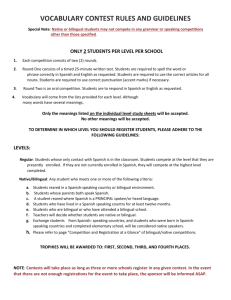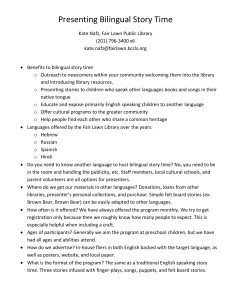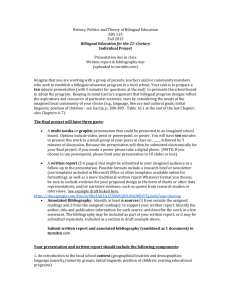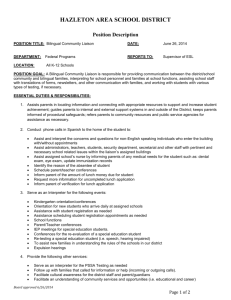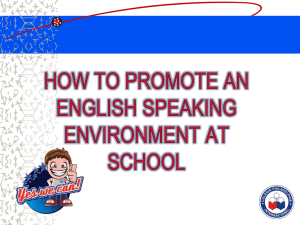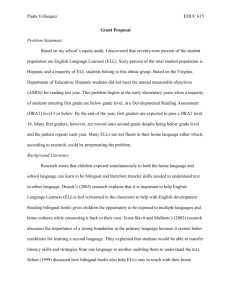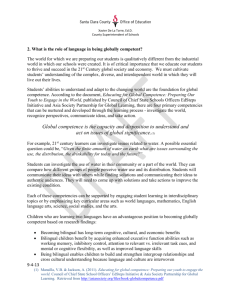File
advertisement
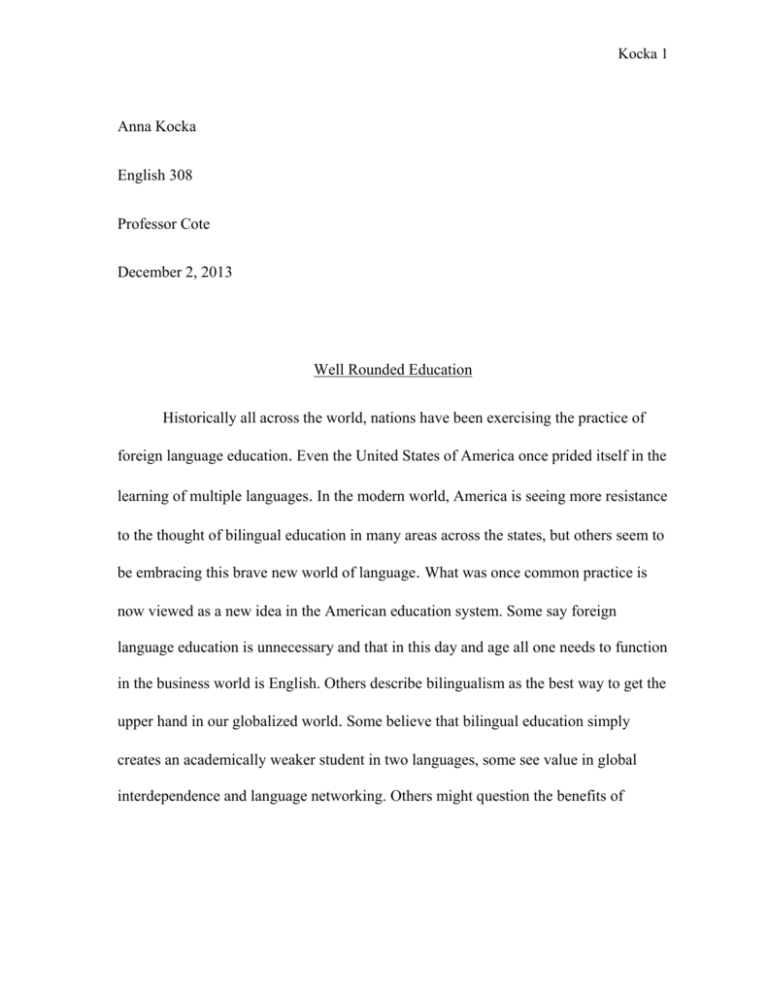
Kocka 1 Anna Kocka English 308 Professor Cote December 2, 2013 Well Rounded Education Historically all across the world, nations have been exercising the practice of foreign language education. Even the United States of America once prided itself in the learning of multiple languages. In the modern world, America is seeing more resistance to the thought of bilingual education in many areas across the states, but others seem to be embracing this brave new world of language. What was once common practice is now viewed as a new idea in the American education system. Some say foreign language education is unnecessary and that in this day and age all one needs to function in the business world is English. Others describe bilingualism as the best way to get the upper hand in our globalized world. Some believe that bilingual education simply creates an academically weaker student in two languages, some see value in global interdependence and language networking. Others might question the benefits of Kocka 2 speaking more than one language in a world where all important situations could be properly dealt with in English. Value of Language Nearly as long as civilizations have been in existence, communication between peoples has been an important part of society. In the present age communication is even more valuable than before. Although globalization has been made easier by the technological advances made in the last century, language is still a valuable skill in everyday life. In Germany, second language, or L2, education starts in the 5th grade. Value is found in the exploration of other languages and cultures that their nation interacts with. It is also widely accepted that English is an important international skill that should be provided from a young age. The second foreign language, or L3, is introduced in the higher school systems during the 7th grade. This is usually a choice between French, Spanish and Latin. Other languages may be available according to school districts and local teacher selections. Clearly, other European languages could be useful in neighboring counties and are therefore taught for business purposes. Latin is also a common root language and assists in many language and science fields that may be later pursued. In the United States of America, it is a rare occasion that a school lower than Middle School or even High School level would offer foreign languages to students. Kocka 3 Some states do not even require any foreign language in order for a student to obtain a high school diploma like Kansas and Illinois (States 2010). In some states, such as Minnesota and Pennsylvania, it is a local decision for schools to require foreign language as a graduation requirement and therefore many students are allowed to graduate without any foreign language knowledge. In many other states, “2 units” of foreign language are required (States 2010). This 2 unit norm is hardly enough for a student to function on any level in that selected foreign language. In the European measurement of foreign language, B2 is the target foreign language level. By B2, a speaker has mastered fluency in most areas but is not yet at a native or university level in all areas (Language). Most American students who study a foreign language in High School barely reach the A1 or A2 levels of language. It is common for a student to graduate with the required amount of language and still have little to no knowledge of the language they have studied. Therefore, the American system of teaching foreign language has been hypothesized as mostly ineffective in a world full of language learners. Bilingual Education It is a common misconception that when someone learns a foreign language, especially in a bilingual school situation, that their L1 will be weakened. However, for a student whose first language is strong in grammar and vocabulary, and L2 can actually strengthen their L1. Learning a second language can help a student better Kocka 4 express themselves with new vocabulary. On the other hand, when a student learns a second language at a young age and their L1 is neglected, the poor foundation of their L1 can actually prevent a strong L2. For example, if a student enters an American school with a basic but weak foundation in Spanish and they learn English, their English skills will suffer from the weakness of their Spanish. There are also many concepts that are easier to grasp in one language than another. For example, in English nouns are only prescribed a gender if they are human and there is one article for “the” and one also two articles “a” and “an”. In German, all nouns are masculine, feminine or neutral. To accompany the three genders of nouns, there are different words for “the”- masculine “der”, feminine “die”, and neutral “das”. When these nouns move from the subject of a sentence, the article also change accordingly. Prepositions also vary from language to language. In Spanish, the word for “on” is used when describing a person moving from one place to another using a vehicle. In English, the preposition “in” would be used. Such concepts can be confusing to a young learner, but will eventually even out in their vocabulary as they strengthen their language skills. In a world where English is a leading business language there is little motivation for English speakers to learn a foreign language. However, the value language holds grows no less over time. If students were to see the value of language as a whole, their reason to learn a foreign language would grow stronger. Even in the United States education stressed the value of languages besides English until after World War I when Kocka 5 it suddenly was “viewed as un-American behavior” (Bilingual 1). In order for the personal value of language to increase, the national perspective of language must be enhanced. As before stated, other countries learn languages earlier, more intensively and more thoroughly than the United States educational system demands. If this standard was raised, the national value of language for the purpose of trade, communication and cultural richness would grow in turn. Styles of Education A few different styles of approach have been created in response to the demand for bilingual education in the United States. “Limited-English speaking children with the same native language must be grouped together in a classroom where they will be taught all subjects in that language- reading, writing, math, science, social studies with a short, daily English language lesson (45 minutes), in the first year. The ratio of native language teaching to English teaching is 80 percent to 20 percent of the school day. In the second year, some subjects will be taught in English, some in the native language, moving to a 50-50 ratio of school time. In the third year, most teaching will be in English, with some language arts still given in the native language, composing an approximate 20-80 ratio favoring English” (Porter 1998). Kocka 6 This system of learning would be called Transitional Bilingual Education. However, in many American schools, there is not enough bilingual staff to create such an atmosphere. On top of that, there are many more languages spoken in the United States schools than teachers who speak those languages. Spanish may be one language that is easy to find teachers for, but the educational system is not prepared to create bilingual classrooms for every language spoken. More realistically, the American education system is utilizing the Dual Language Immersion approach. This style incorporates two languages in order to create an atmosphere receptive to natives of both languages. Benefits of Bilingual Education Locally So one might wonder what the benefits of bilingual education are. When children are of the elementary school age, students are learning language at a rate other age groups cannot. The idea of a bilingual program is to utilize the abilities of the young learners. In Harrisonburg, Virginia alone, many schools are realizing the importance of language learning, specifically Spanish. In Harrisonburg City’s own Waterman Elementary school, many students are learning Spanish along with their foundational curriculum. The principle of Waterman Elementary, Jeremy Weaver, says “There is a lot of research and lots of studies that show that kids can learn languages more quickly especially when they’re younger. ..The kids (at Waterman) have the opportunity to learn basic words and school words and we have found that there’s benefit there” (Giron 22). The idea behind introducing Spanish so early is that there Kocka 7 will be will a strong foundation for students to improve their Spanish if they choose to during their later years of education. Harrisonburg City schools are also moving toward providing bilingual education options for both English language learners and native English speakers. In Smithland Elementary School, half the day is offered in Spanish and half the day is in English. Not only does this Dual Language Immersion program help native English speakers to learn Spanish at a young age, but the split day helps English language learners to succeed in their academics in an environment that traditionally stifles students who are not fully English proficient. Principle Gary Painter of Smithland Elementary in Harrisonburg Virginia says “We want children to appreciate and interact with other cultures. Being bilingual opens you up to new worlds” (Duda 25). Smithland hopes that by providing bilingual education, both native English speakers and English language learners will benefit. Benefit in the Long Run As students learn a second language in elementary school, the hope is that the school systems are creating academically strong and well-rounded individuals. Bilingualism is a valuable characteristic in this modern age and by implementing bilingual education in many school districts, students are given an opportunity to succeed in their future with this new language skill. Kocka 8 Bibliography Page "Bilingual Education in the United States - Springer." Bilingual Education in the United States - Springer. N.p., n.d. Web. 27 Nov. 2013. <http://link.springer.com/chapter/10.1007/978-94-011-4531-2_19#page-2>. Duda, Mark. "Dual Language Immersion Expands at Smithland." Harrisonburg City Public Schools 1 Aug. 2012: 25. Print. Giron, Victoria. "Waterman introduces Spanish Program." Harrisonburg City Public Schools 1 Aug. 2012: 22. Print. "Language Self- Assessment Grid." Council of Europe. N.p., n.d. Web. 21 Nov. 2013. <http://www.ema.europa.eu/docs/en_GB/document_library/Other/2010/03/WC 500075218.pdf>. Porter, Ed. D. Rosalie. "The Failure of Bilingual Education." The Communitarian Network. READ Institute, n.d. Web. 1 Dec. 2013. <http://www.gwu.edu/~ccps/pop_billing.html>. "States with or Considering High School Foreign Language Graduation Requirements." National Council for Social Studies. N.p., 1 Mar. 2010. Web. 22 Nov. 2013. <http://www.ncssfl.org/docs/States%20with%20Foreign%20Language%20Grad uation%20Requirements%20-%20%20Revised%202010.pdf>.
